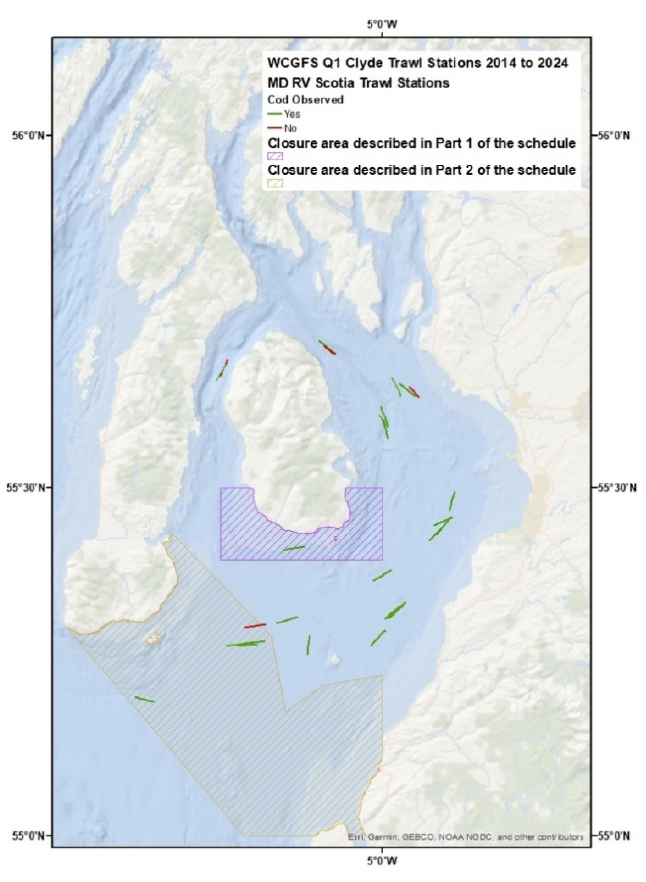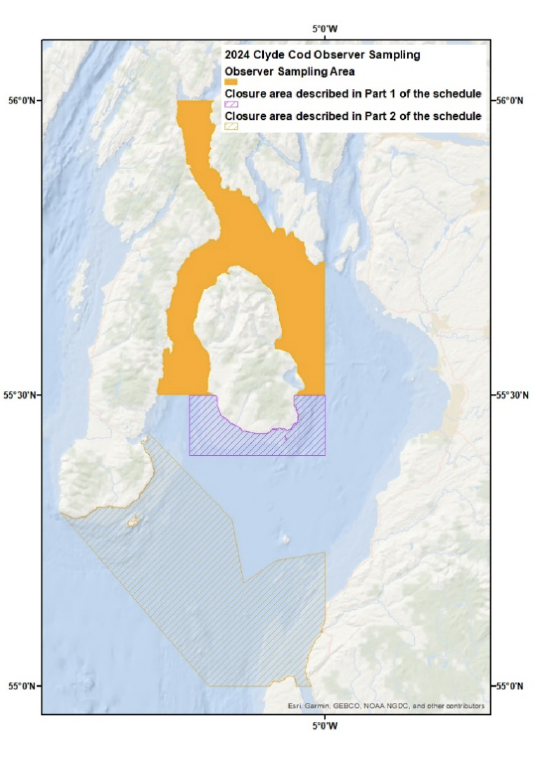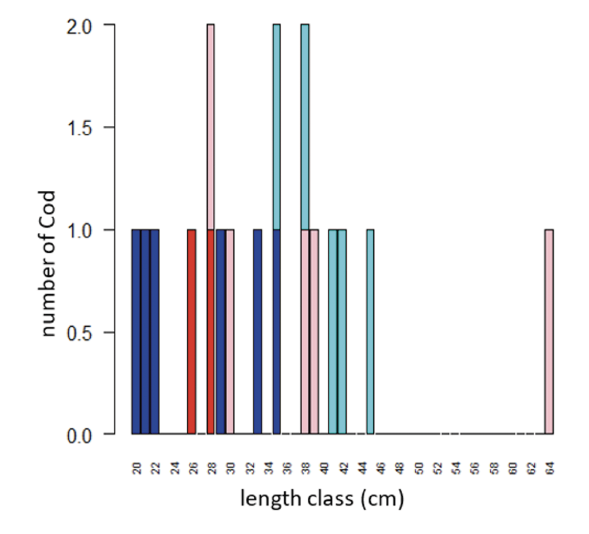Clyde Cod closure 2024: report
Report on the 2024 Clyde Cod Closure, detailing both scientific and compliance work carried out in support of this management measure.
2. Science
During the spawning closure in Q1 2024, additional scientific work was carried out across four main strands including: a) enhanced observer coverage of the commercial fleet to carry out sampling work, b) passive acoustic monitoring within the closure area to identify the presence of spawning cod, c) a science presence on Marine Protection Vessels (MPV) during boarding and subsequent catch analysis to build on the monitoring carried out in 2022 and 2023; and d) additional research vessel effort during the Q1 West Coast Ground Fish Survey.
The passive acoustic monitoring data have yet to be analysed. The data analysed here were obtained from the enhanced observer coverage and research vessel trawls conducted routinely in the Clyde during March each year.
2.1 Research Vessel Data
The Clyde is surveyed by the Marine Directorate during the annual Q1 Scottish West Coast Ground Fish Survey by Fisheries Research Vessel Scotia with Marine Directorate scientific staff, operating under the governance of the ICES International Bottom Trawl Survey Working Group[6]. The survey in its current design, includes three randomised bottom trawl stations of 30 minutes’ standard duration within the Clyde area, carried out between mid-February and mid-March each year. In the previous ten surveys from 2014 to 2024 (the survey not being conducted in 2022 due to a vessel breakdown), a total of 31 valid trawl stations were completed. Trawls were carried out in a variety of locations throughout the Clyde with cod observed in all trawl stations except for four, as highlighted in red in Figure 2 below. A total of 8 valid trawl stations were conducted in the designated closure areas where bottom trawl fishing is now prohibited, with 23 valid stations conducted outside the closure areas.
The number of cod observations in the Clyde each year is relatively low, with an average of 16.3 cod observed each year, implying a mean of 5.2 per 30-minute tow. Separating the results into observations from the closure areas compared to the remainder of the Clyde, the average number of cod per 30-minute tow inside the closure areas was substantially higher with 10.3 cod observed, whereas outside the closure areas 3.5 cod were observed. It must be noted that these numbers are heavily influenced by a large catch during the 2017 survey where 52 individuals were observed at a single station inside the closure area described in Part 2 of the schedule. Discounting this observation results in the average number of cod observed in the Clyde being 11.4 per year (3.7 cod per 30-minute tow) whilst comparing the closure areas to the remainder of the Clyde results in similar numbers of 4.5 cod per 30-minute tow inside, and 3.5 cod per 30-minute tow outside closure areas. The low number of trawls and the randomised survey design makes it difficult to determine where spawning cod aggregations are most prevalent, as trawl station observations cannot be directly compared between years or areas. Additionally, exceptionally large catches skew the data, and bottom variation has an effect on catch variability when compared to a fixed station survey. Whilst the comparison of numbers of cod is difficult and requires a stock assessment process, there are some deductions that can be made from the observations, primarily from the biological data collected.

Biological data, including maturity stage, were collected from individual cod during the surveys according to the biological targets for each survey (Table 1). It must be noted that maturity data prior to 2024 is not as clearly defined as data collected from 2024 onwards, due to a new maturity staging process using the Sexual Maturity Staging in Fish (SMSF) scale detailed in the appendix. Fish classified as maturity stage 4 (spawning capable) and 5 (actively spawning) in the 2024 SMSF scale are equivalent to stage 3 of the previous scale (used prior to 2024), and were classified together as “spawning”[7]. The biological data shows that spawning cod can be found throughout the Clyde, including actively spawning cod outside the closure areas in 2024. The overall percentage of observed cod that were spawning within the closure areas was 43.8%, with 40.8% of observed cod that were spawning found outside the closure areas. This highlights that there isn’t a substantial difference in the percentage of observed cod that were seen to be spawning inside or outside the closure areas. Furthermore, it can be deduced from the results that the cod biological data are similar when compared between areas, with maturity, age, spawning age, average size, and proportion of male and female varying only slightly.
| No. of Immature Cod | No. of Mature Cod | No. of Spawning Cod | Percentage spawning Cod | Average Age of Cod (years) | Average Age of Spawning Cod (years) | Average Size of Cod (cm) | Average Size of Spawning Cod (cm) | No. of Female Cod | No. of Female Spawning Cod | No. of Male Cod | No. of Male Spawning Cod | |
|---|---|---|---|---|---|---|---|---|---|---|---|---|
| Inside Closure | 16 | 64 | 35 | 43.8% | 2.04 | 2.11 | 41.3 | 43.5 | 31 | 5 | 49 | 30 |
| Outside Closure | 21 | 56 | 32 | 40.8% | 2.12 | 2.59 | 42.2 | 53.3 | 30 | 11 | 46 | 21 |
The above observations go further to highlight the requirement for further scientific surveying within areas with fisheries management measures, enabling monitoring and comparisons to take place. Without previous survey data, a comparison would not be possible between the closure areas and the remainder of the Clyde, reducing the ability to interpret the data and thusly a reduction in the quality of the scientific advice. Further investigation requiring a more in-depth scientific survey of the Clyde cod population both inside and outside closure areas during the spawning season is required if a better understanding of the effectiveness of the closure areas is sought, or whether the closure areas are suitable to protect spawning cod.
2.2 Observer Data
The Scottish Demersal Joint Observer Programme is scheme undertaken each year by the Science Evidence Data and Digital Portfolio (SEDD) of the Marine Directorate of the Scottish Government and the Scottish Fishermen’s Federation (SFF). It is a statistical survey using scientific observers to sample biological information from catch on board vessels, carried out under the UK's implementation of the Data Collection Framework legislation[8] (as amended in assimilated law), which covers around 1-2% of trawl fishing trips per year. Approximately 4 or 5 observer trips to collect finfish bycatch data on Nephrops trawlers are achieved in the Clyde each year, although during the covid pandemic the programme was less successful due to health and safety considerations. These observer trips do not routinely collect data on cod maturity.
Four dedicated observer trips were planned to take place during the closure. Vessels were selected using a randomised list developed by SEDD for 2024, focussing on Clyde Fishermen’s Association (CFA) members who had indicated a willingness to be approached.
Three of the four planned observer trips were successfully completed on two different vessels. One trip was not completed due to a lack of available trained staff in the planned time frame. An additional catch-up trip was not completed due to a lack of available vessels in the planned time frame.
The biological sampling of all cod bycaught by the vessels for each haul was carried out in addition to the usual sampling of bycatch on observer trips. For each fish, length, sex and maturity stage, (using the SMSF Scale 2024: Appendix A, Figures A1 and A2) were collected. Spawning fish were determined using the same method as for the research vessel survey data described in Section 1.
Over the course of the 3 fishing trips observed there were a total of 9 successful trawls in ICES rectangle 40E4 (ICES Division 6a within the Clyde functional unit), all north of the closure areas (Figure 3). A total of 7 cod were found in the sampled bycatch compared to 1817 fish of other species, indicating that the proportion of cod bycaught on the observed fishing trips was very small compared to other species in the bycatch. There were 18 individual cod captured in 5 trawls, an average of 2 cod per haul overall. Ten cod (56%) were determined to be mature, and 7 (39%) were determined to be spawning (Table 2). Immature fish tended to be smaller than mature and spawning fish (Table 2, Figure 4). However, given the small number of fish caught and trips observed, it is difficult to conclude more than to confirm the presence of spawning cod in the locations fished, and the low proportion of cod in the catches of the observed trips.
| No. of Immature Cod | No. of Mature Cod | No. of Spawning Cod | Percentage of Mature Cod | Percentage of Spawning Cod | Average Size of Cod (cm) | Average Size of Spawning Cod (cm) | No. of Female Cod | No. of Female Spawning Cod | No. of Male Cod | No. of Male Spawning Cod | |
|---|---|---|---|---|---|---|---|---|---|---|---|
| Outside Closure | 8 | 10 | 7 | 55.6% | 38.9% | 34.1 | 40.4 | 7 | 4 | 11 | 3 |


Contact
Email: inshore@gov.scot
There is a problem
Thanks for your feedback